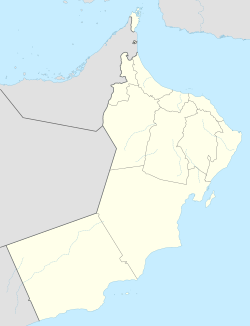 | |
| Location | Ash Shiṣr, Thumrayt, Dhofar |
|---|---|
| Coordinates | 18°15′18″N 53°38′56″E / 18.25500°N 53.64889°E |
| Type | Trading post |
| Part of | Land of Frankincense |
| History | |
| Founded | 4th century[1] |
| Abandoned | 15th–16th century[1] |
The archaeological site of Shisr is located next to the village of Ash Shiṣr in Dhofar, Oman. It used to be an oasis. The settlement was an inland trading post and has been a UNESCO World Heritage Site Land of Frankincense since 2000.
Some considered it to be the legendary lost city of Ubar or Iram. This is not always accepted by scholars.[2][3][4] There is a probability that it might have been in the land of Ubar which was a historical region rather than a city. The site might have inspired the legend of the lost city of Ubar when the spring dried up and the settlement was abandoned. [5]
References
- ^ a b Newton, Lynne S.; Zarins, Juris (2019). Dhofar through the Ages: An Ecological, Archaeological and Historical Landscape. Oxford: Archaeopress. pp. 114–115. ISBN 978-1-78969-160-3.
- ^ Edgell, H. Stewart (2004). "The myth of the "lost city of the Arabian Sands"". Proceedings of the Seminar for Arabian Studies. 34: 105–120. ISSN 0308-8421.
- ^ Tkatsch, J.; Costa, P. M. (2012-04-24). "Wabār". Encyclopaedia of Islam, Second Edition. Brill.
- ^ Webb, Peter (2019-06-01). "Iram". Encyclopaedia of Islam, THREE. Brill.
- ^ Blom, Ronald G.; Crippen, Robert; Elachi, Charles; Clapp, Nicholas; Hedges, George R.; Zarins, Juris (2007). "Southern Arabian Desert Trade Routes, Frankincense, Myrrh, and the Ubar Legend". In Wiseman, James (ed.). Remote Sensing in Archaeology. Interdisciplinary Contributions To Archaeology. New York, NY: Springer. pp. 71–87. doi:10.1007/0-387-44455-6_3. ISBN 978-0-387-44455-0.









